Methodology of Creating and Sustainable Applying of Stereoscopic Recording in the Industrial Engineering Sector
Abstract
:1. Introduction
2. Materials and Methods
2.1. Methodology of Goal-Directed Stereoscopic Recording and Its Production
- Process of camera data collection;
- Process of display device data collection;
- Process of scanned area data collection.
- Parallel camera axes;
- Converging camera axes.
2.1.1. Process of Camera Data Collection
- Focal lens distance “f”;
- Recording medium width (CCD, …) “q”.
2.1.2. Process of Display Device Data Collection
- Expert analysis creation of the current state by one specialist. In this case, a stereoscopic recording is being watched by one spectator. Use of a stereoscopic screen, which is connected to a workstation, creator of relevant analyses, could be a good solution.
- Expert analysis creation of the current state by a small group of specialists. In this case, it is a group of two to four specialists who analyze current state by relevant analyses. The use of a stereoscopic TV is the appropriate solution that makes watching a stereoscopic recording comfortable for a smaller group of people.
- Induction use and presentation of results. For instance, it is a presentation of a stereoscopic recording to a larger group of people. The use of the stereoscopic projector in an adapted presentation room. The most important requirement is to black-out the room and prevent direct sunlight.
2.1.3. Process of Space Data Collection
- Parallel camera axes (Section 2.1.4);
- Converging camera axes (Section 2.1.5 and Section 2.1.6).
2.1.4. Process of Input Parameter Calculation for Parallel Camera Axes Option
- Observer’s distance change;
- Camera’s position change;
- Change in a way of a stereoscopic recording production.
2.1.5. Process of Convergence Point Determination
2.1.6. Process of the Input Parameter Calculation for Converging Camera Axis Variation
- The distance of the convergence point is shorter or equal to the distance of the closest recorded point.
- The distance of the convergence point is longer compared to the distance of the closest recorded point. It is also shorter than the distance of the furthest recorded point.
- The distance of the convergence point is longer or equal to the distance of the furthest recorded point.
- Δqk/2: Half of the mutual point shift’s absolute value (its value could be determined according to the maximum recommended value of an observation angle);
- k: The distance of the closest recorded point;
- l: The distance of the convergence point.
- Convergence point change;
- Observer’s distance change;
- Camera position change;
- Change in a way of producing the stereoscopic recording.
2.1.7. Set of Recommendations and Warnings When Producing Stereoscopic Material
- The main difference between the two ways of stereoscopic recording is the parallel camera axes variation is much easier with a lower risk of mistake when producing the stereoscopic recording. However, the converging axes variation enables area recording from a shorter distance, when the convergence point is in an optimal position. This is the case for the parallel axes too.
- The most important parameter of the converging camera axes variation is a position of the convergence point. This is because it creates a border between positive and negative parallax and it consequently determines parameters of perceived space when producing the stereoscopic recording. Also, its deviation level from optimal position has a big influence on the value of the final and correctly recorded space.
- When producing a stereoscopic recording, all objects and people that are placed at the front of recording (closest objects and people) should always be complete in both camera scenes. A trimmed image of the closest objects and people is disturbing whilst watching a stereoscopic image. It partially disturbs the observer’s fully-fledged spatial perception.
- The easiest solution for tired eyes after a long stereoscopic recording watching is making the distance from the observer and display device longer.
- The best spatial perception is created when watching an image from a shorter distance than the width of the display device. However, watching the image from such a short distance requires an appropriate recording (lower values of mutual image shift).
- Given the risk of image distortion with converging camera axes, the value of the stereoscopic base should not exceed 10 cm.
3. Results
3.1. Verifying Solutions in Practice
3.1.1. Verification and Validation of Derived Formulas and Accuracy of the 3D Camera System
- Imprecisions in measuring unit setting of a camera system (laser pointer);
- Imprecisions in camera system setting;
- Imprecisions in space parameter measuring;
- Imprecisions in measuring the final parameters of stereoscopic recording.
3.1.2. Practical Applicability Check When Making Ergonomic Analysis
- Load analysis creation;
- Time analysis creation;
- Identification of ergonomic problems in the workplace;
- Analysis of keeping work procedure.
- Choosing a suitable position for the stereoscopic recording’s production.When choosing a suitable camera position, the most important criterion is a recorded space, given the needs of a detailed workplace analysis. It is necessary for the entire workplace of an assessed operation to be recorded. It must be recorded with all its elements. Moreover, it is necessary all the worker’s operations are clearly visible, with clear hand movement.
- Camera system parameter setting.For a quick camera system setting, it is possible to process its calculations into a form of a calculation file that will correctly re-calculate the camera set in a particular space.
- Recording production.When producing a recording it is necessary for at least one complete cycle of an analyzed operation to be recorded. In order to have a better review of the work procedure, it is advised to have more of these cycles recorded.
- Recording processing and editing.Processing consists of editing recorded recordings. The whole process must be recorded, from start till end. In this step, synchronization of a stereoscopic video recording is carried out too.
- Analysis of potentially risky activities and operations. When analyzing a workplace, the ergonomist does not create an analysis of all workers’ activities and operations. Such an approach would be very difficult and ineffective. Ergonomist, thanks to his knowledge and experience, needs to quickly identify potential risky activities and operations which he will later analyze in detail. The spatial vision of a particular situation eliminates the need for spatial imagination of the ergonomist and enables him to quickly and effectively identify potential risky activities and operations.
- Detailed analysis of selected activities and operations. After selecting these potentially risky activities and operations, they are analyzed in detail afterward. Detailed analysis of particular activities requires information about the spatial orientation of a worker during the analyzed situation. Moreover, spatial reproduction of the particular activity’s recording is an appropriate supportive tool that provides necessary information as well as quick and quality making of required analyses.
4. Discussion
- The stereoscopic visualization application provides better vision about the spatial layout of the workplace and about spatial orientation of the operator in the workplace when they do their work activities. This was most relevant in the application of stereoscopy in the field of ergonomic analysis of operator work activities. A number of ergonomic analyses were assessed based on the current spatial position of operator orientation, e.g., Ovako Working posture Analysis System (OWAS), RULA, REBA, National Institute for Occupational Safety and Health (NIOSH), low back analysis, static strength prediction, strain index, and Ergonomic Assessment Work-Sheet (EAWS). For all of these analyses, it was a crucial correct evaluation of the actual spatial orientation of the operator, which can be determined very heavily and with insufficient accuracy by using classic 2D records. The study showed that stereoscopic recording and visualization could make easier the determination of the operator’s location in the workspace.
- For creating stereoscopic records in industrial practice, commercially available camera systems are only applicable under restricted conditions. Commercially available stereoscopic camera systems are primarily designed for use in the entertainment industry or in domestic conditions when creating private movies. Camera systems designed for use in the entertainment industry are characterized by very high quality of use but are also very sturdy and expensive. However, in the case of 3D camera systems for home use, they are affordable but they can be used under a number of limitations. This limitation can be the minimum distance of the nearest point of vision or the minimum possibility of setting the shooting parameters, e.g., the distance and angle of the camera convergence. All these restrictions on available systems are based on their primary conditions of use. In case of creating a recording by the entertainment industry or in the home, we can adapt some elements of recorded space to the camera system parameter, but this adaptation is not possible when recording in the industrial environment. This is because the possibility of organizing the workspace to improve the stereoscopic record could result in distortion of the operator’s activities performed. This could lead to a deterioration of results when ergonomic analyses are carried out, which would not necessarily reflect the real situation in the workplace.
- When we create our own camera system with a sufficient number of degrees of freedom setting of the scanning parameters, we need to design the algorithm to correct these parameters. The proposed algorithm, along with the derived basic geometry of the stereoscopic camera system with converging camera axes, formed the core of the presented study. The application of the presented procedure will allow for creating high quality and precise stereoscopic records, which, will also respect the biological limits of human vision. The procedure guides the user through the process of acquiring basic input data, which are then used to calculate the resulting parameters of the camera system setting to achieving a quality stereoscopic recording. The geometric model and derived formulas contain a certain degree of simplification, which was assessed as acceptable on the basis of the monitoring of created records. The accuracy of the calculation could be increased, for example, by application of the lens display equation [16] to the original calculation. This could be focused on future work in developing the presented study.
5. Conclusions
- Possible workplace collisions;
- Identification of workplace ergonomic problems;
- The physical presence of an ergonomist is not necessary when making an analysis;
- The possibility of repeated operator’s tasks’ observation and detailed observation of particular tasks;
- Possibility to review workplace order;
- Possibility to review whether correct procedures of individual operations are kept;
- Possibility to analyze how human potential could be used more effectively.
6. Patents
Author Contributions
Acknowledgments
Conflicts of Interest
References
- Holmes, O.W. The Stereoscope and the Stereograph. 1859. Available online: http://www.stereoscopy.com/library/holmes-stereoscope-stereograph.html (accessed on 20 February 2019).
- Wheatstone, C.H. Contributions to the Physiology of Vision—Part the First. 1838. Available online: http://www.stereoscopy.com/library/wheatstone-paper1838.html (accessed on 20 February 2019).
- Wheatstone, C.H. Contributions to the Physiology of Vision—Part the Second. 1852. Available online: http://www.stereoscopy.com/library/wheatstone-paper1852.html (accessed on 20 February 2019).
- McKay, H.C. Three Dimensional Photography. 1953. Available online: http://3d.curtin.edu.au/library/mckay.cfm (accessed on 20 February 2019).
- Lipton, L. Foundations of the Stereoscopic Cinema. 1982. Available online: http://3d.curtin.edu.au/library/foundation.cfm (accessed on 20 February 2019).
- Howard, I.P.; Rogers, J. Binocular and Stereopsis; Oxford Psychology Series; Oxford University Press: Oxford, UK, 1995; ISBN 978-0195084764. [Google Scholar] [CrossRef]
- Bimper, O.; Raskar, R. Spatial Augmented Reality; A K Peters/CRC Press: Wellesley, MA, USA, 2005; ISBN 978-1-56881-230-4. [Google Scholar]
- Lee, C.H.; Diverdi, S.; Höllerer, T. An Immaterial Depth-Fused 3D Display; ACM: New York, NY, USA, 2007; ISBN 978-1-59593-863-3. [Google Scholar] [CrossRef]
- Martín, S.; Suárez, J.; Orea, R.; Rubio, R.; Gallego, R. GLSV: Graphics library stereo vision for OpenGL. Virtual Real. 2009, 8, 51–57. [Google Scholar] [CrossRef]
- Livesey, R.J. Some stereoscopic studies of the moon. J. Br. Astron. Assoc. 1971, 82, 38–41. [Google Scholar]
- Merchant, A.C. Three-Dimensional Stereoscopic Anatomy. Arthrosc. J. Arthrosc. Relat. Surg. 2011, 27, 1603. [Google Scholar] [CrossRef] [PubMed]
- Halfen, A.F. A New Stereoscopic (3D) Media Database and Teaching Strategy for Use in Large-Lecture Introductory Geoscience Courses. J. Geosci. Educ. 2014, 62, 515–531. [Google Scholar] [CrossRef]
- Bruno, F.; Caruso, F.; Napoli, L.; Muzzupappa, M. Visualization of industrial engineering data visualization of industrial engineering data in augmented reality. J. Vis. 2006, 9, 319–329. [Google Scholar] [CrossRef]
- Bougaa, M.; Bornhofen, S.; Kadima, H.; Rivière, A. Virtual Reality for Manufacturing Engineering, The Factories of the Future 2015, Applied Mechanics and Materials. pp. 789–790. Available online: www.scientific.net/AMM.789-790.1275 (accessed on 20 February 2019).
- Wolfartsberger, J.; Zenisek, J.; Sievi, C. Chances and Limitations of a Virtual Reality-supported Tool for Decision Making in Industrial Engineering. IFAC-PapersOnLine 2018, 51, 637–642. [Google Scholar] [CrossRef]
- Červeň, I. Fyzika po kapitolách—Optika; Slovenská technická univerzita: Bratislava, Slovakia, 2007; p. 75. ISBN 978-80-227-2674-0. [Google Scholar]
- Gašo, M.; Tureková, H. Význam Panúmovej oblasti pri tvorbe stereoskopických záznamov. In Pokrokové Priemyselné Inžinierstvo, Proceeding of the Invent 2010, Terchova, Slovakia, June 2010; GEORG: Terchova, Slovakia, 2010; pp. 132–135. ISBN 978-80-89401-12-3. [Google Scholar]
- Gašo, M. Ergonómia stereoskopických záznamov. In Proceedings of the Stereoskopických Záznamov. Ergonómia 2010—Progresívne Metódy v Ergonómii, Zborník Prednášok, Žilina, Slovakia, 24–25 November 2010; pp. 106–110, ISBN 978-80-970588-6-9. [Google Scholar]
- Gašo, M.; Smutná, M. The relation of input quantities for creation of stereoscopic record. In Proceedings of the Transcom 2011—9th European Conference of Young Research and Scientific Workers, Žilina, Slovakia, 27–29 June 2011; pp. 59–62, ISBN 978-80-554-0370-0. [Google Scholar]
- Available online: https://www.pcrevue.sk/a/Ako-vyberat-televizor (accessed on 28 March 2019).
- Available online: https://prevodyonline.eu/sk/vzdialenost-tv.html (accessed on 28 March 2019).
- Available online: https://www.samsung.com/sk/tvs/sprievodca/uhlopriecka/ (accessed on 28 March 2019).
- Available online: https://www.nvidia.com/object/3d-vision-main.html (accessed on 28 March 2019).
- Available online: http://www.depthq.com/ (accessed on 28 March 2019).
- Slamková, E.; Dulina, L.; Tabaková, M. Ergonómia v Priemysle; GEORG: Žilina, Slovakia, 2010; p. 262. ISBN 978-80-89401-09-3. [Google Scholar]
- Smutná, M.; Dulina, L. Metódy a Softvérová Podpora v Priemyselnej Ergonómii; Slovenská Ergonomická Spoločnosť (SES): Žilina, Slovakia, 2010; p. 146. ISBN 978-80-970525-6-0. [Google Scholar]
- Gregor, M.; Medvecký, Š.; Mičieta, B.; Matuszek, J.; Hrčeková, A. Digitálny Podnik; KRUPA Print Žilina: Žilina, Slovakia, 2006; p. 148. ISBN 80-969391-5-7. [Google Scholar]
- Gašo, M.; Mičieta, B. Spôsob Určenia Bodu Konvergencie a Veľkosti Stereoskopickej Základne s Konvergujúcimi Osami Kamier; Úžitkový vzor č. 7683; Úrad Priemyselného Vlastníctva: Banská Bystrica, Slovakia, 2016; p. 11. [Google Scholar]
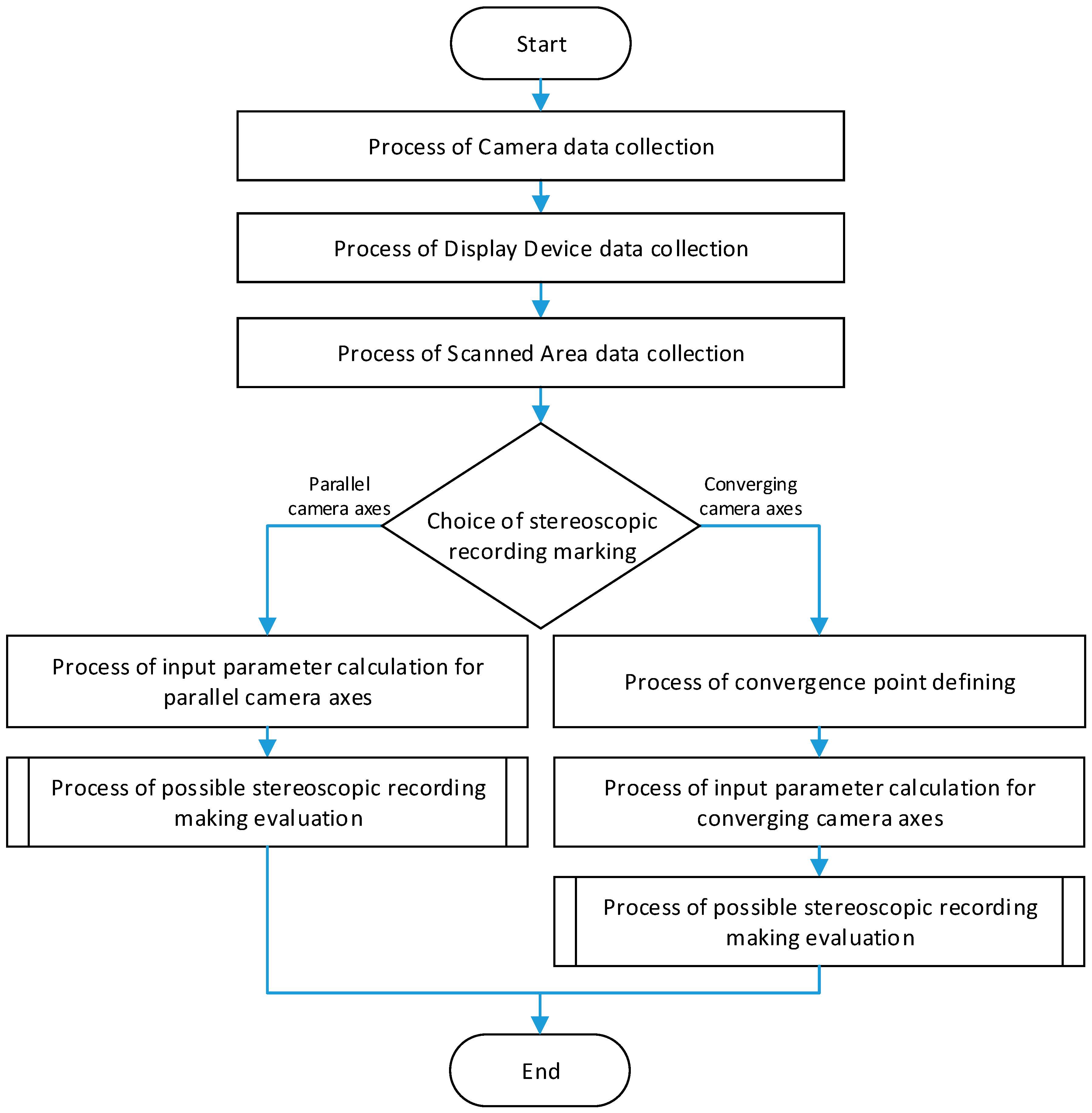
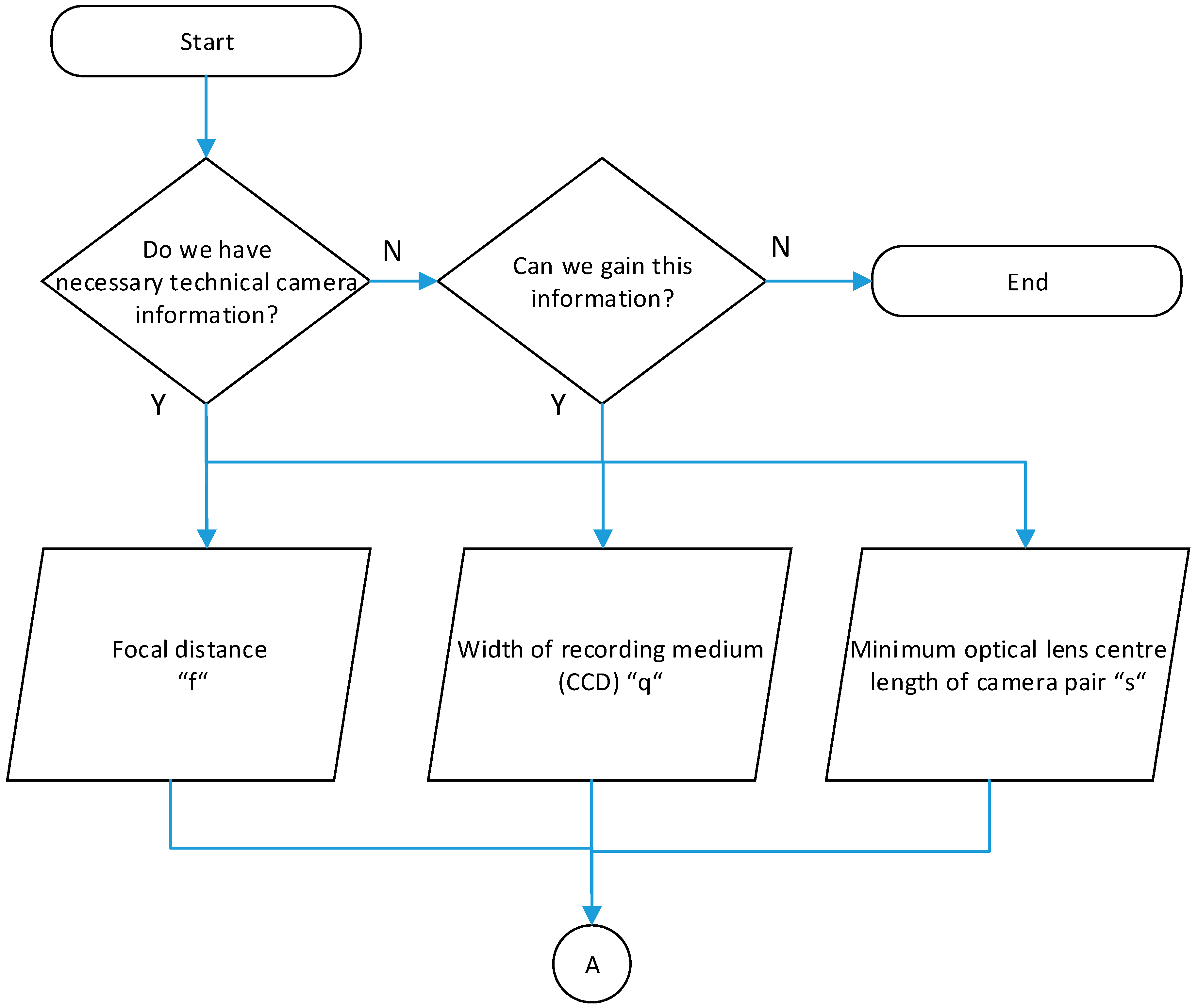
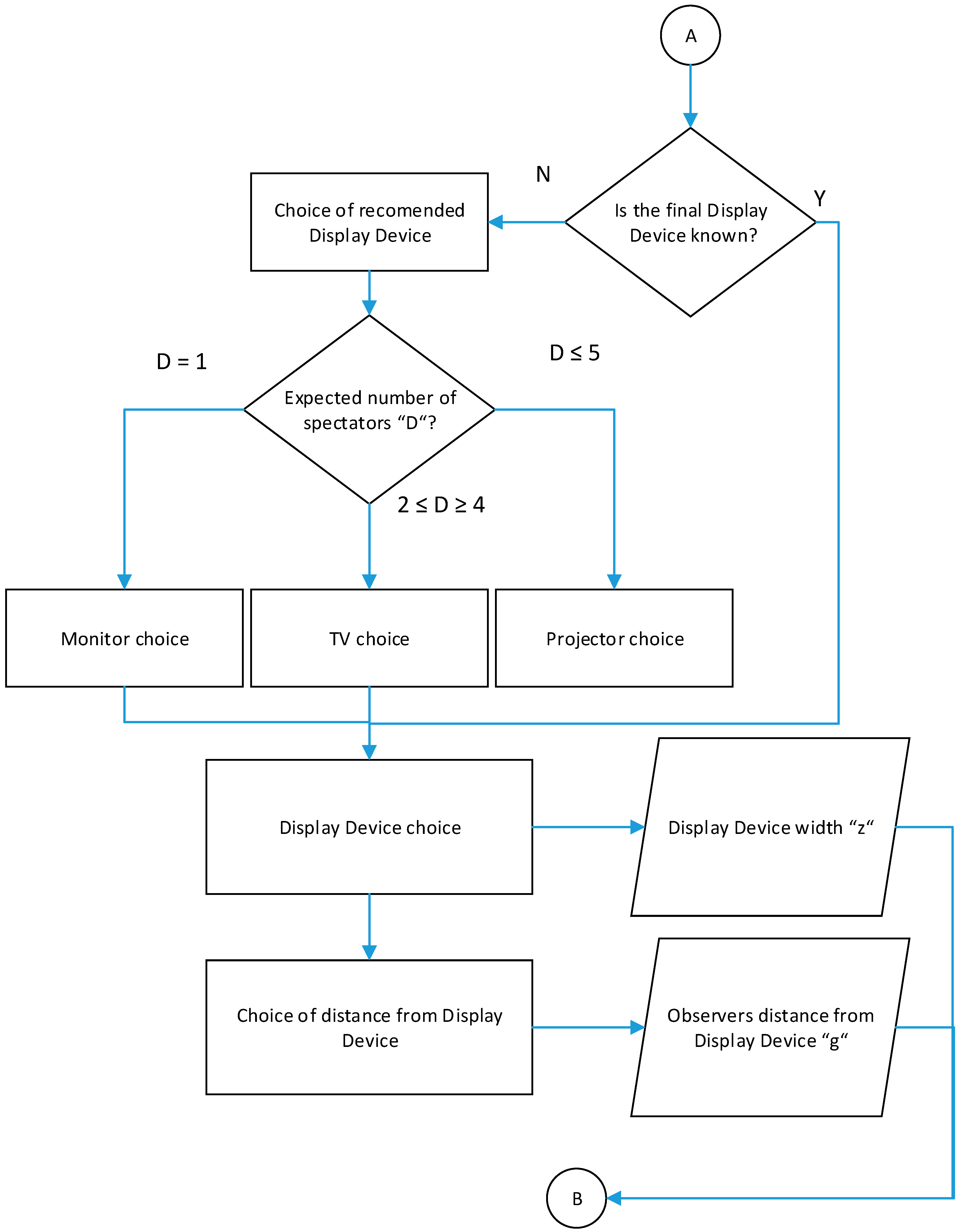
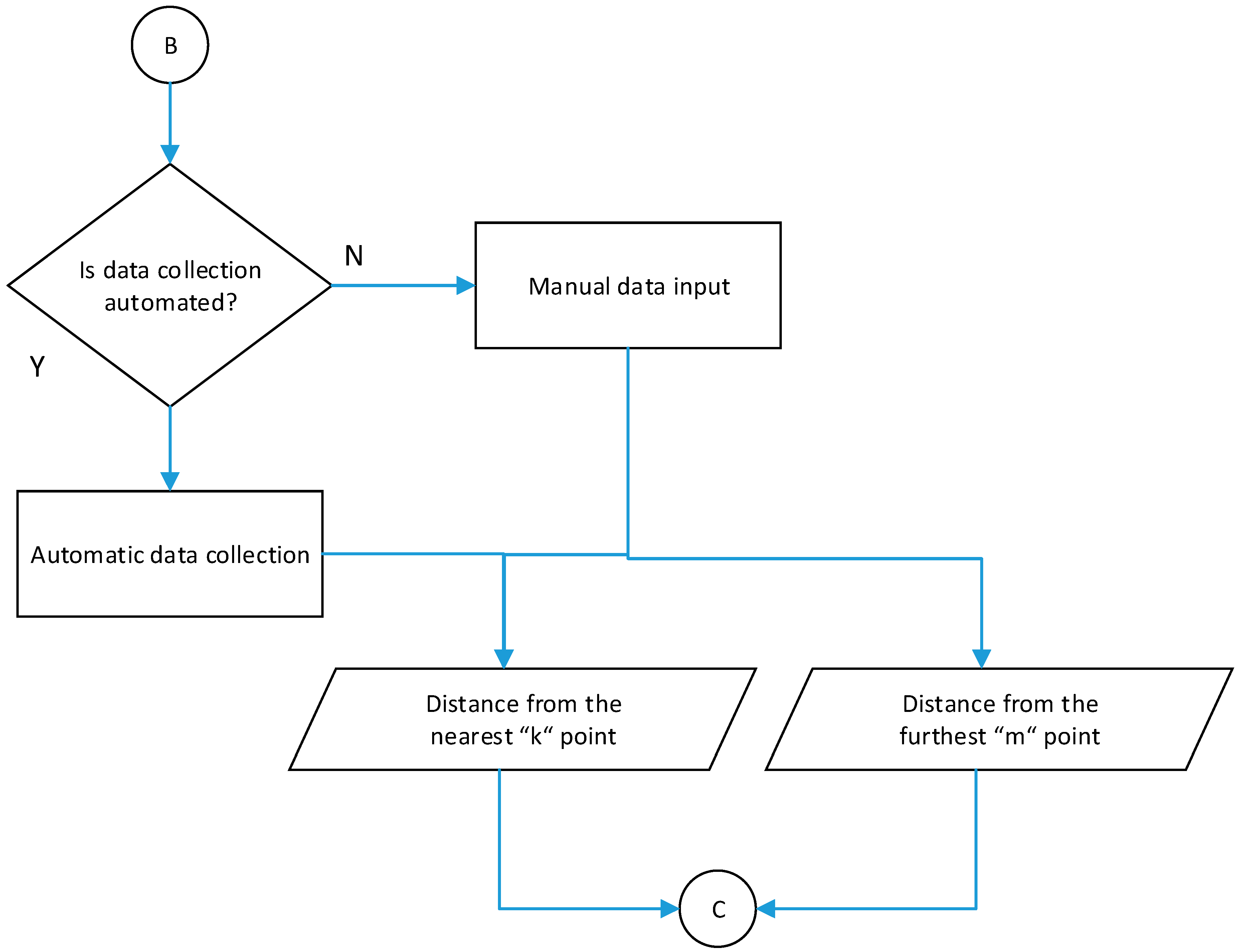
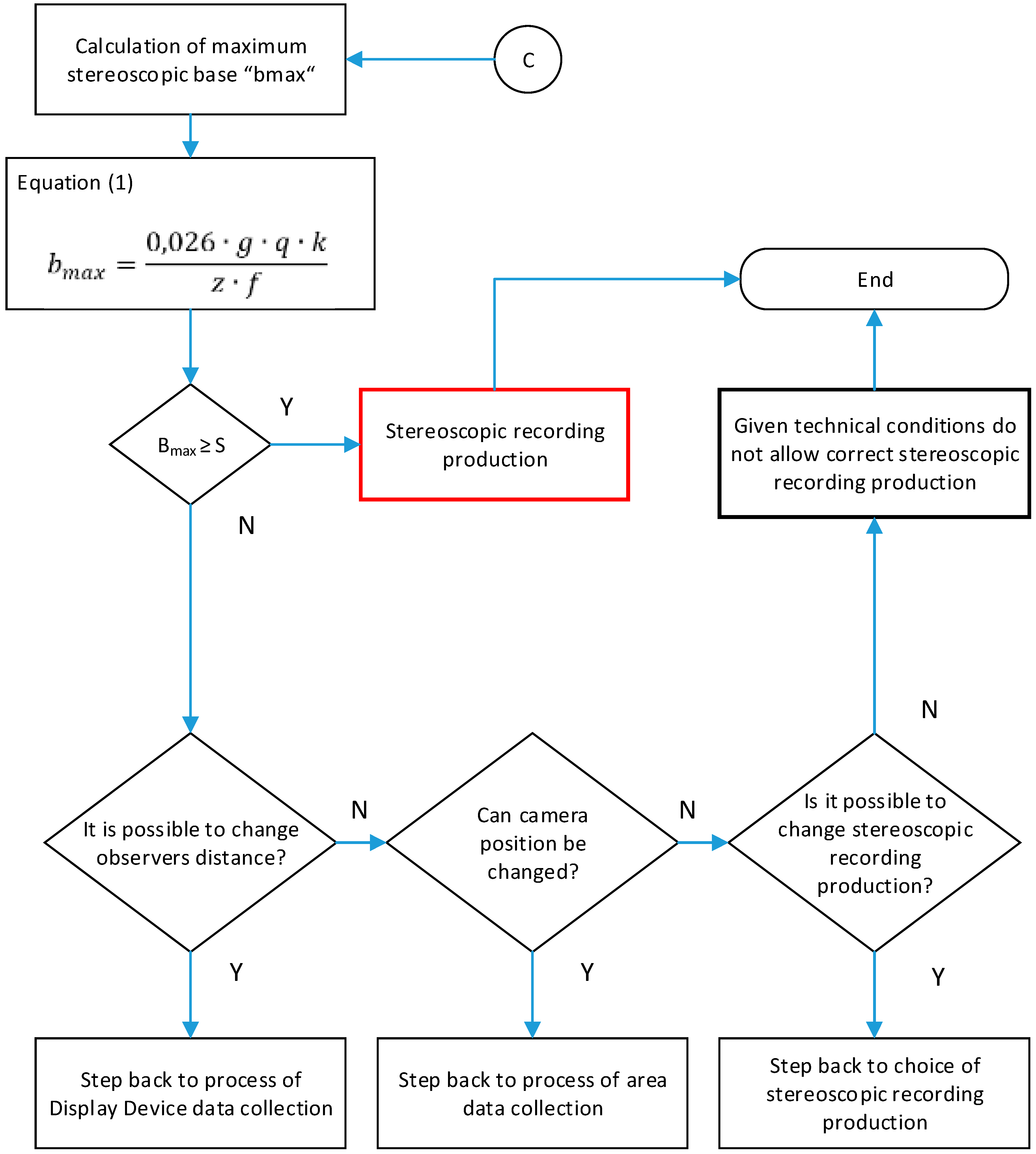
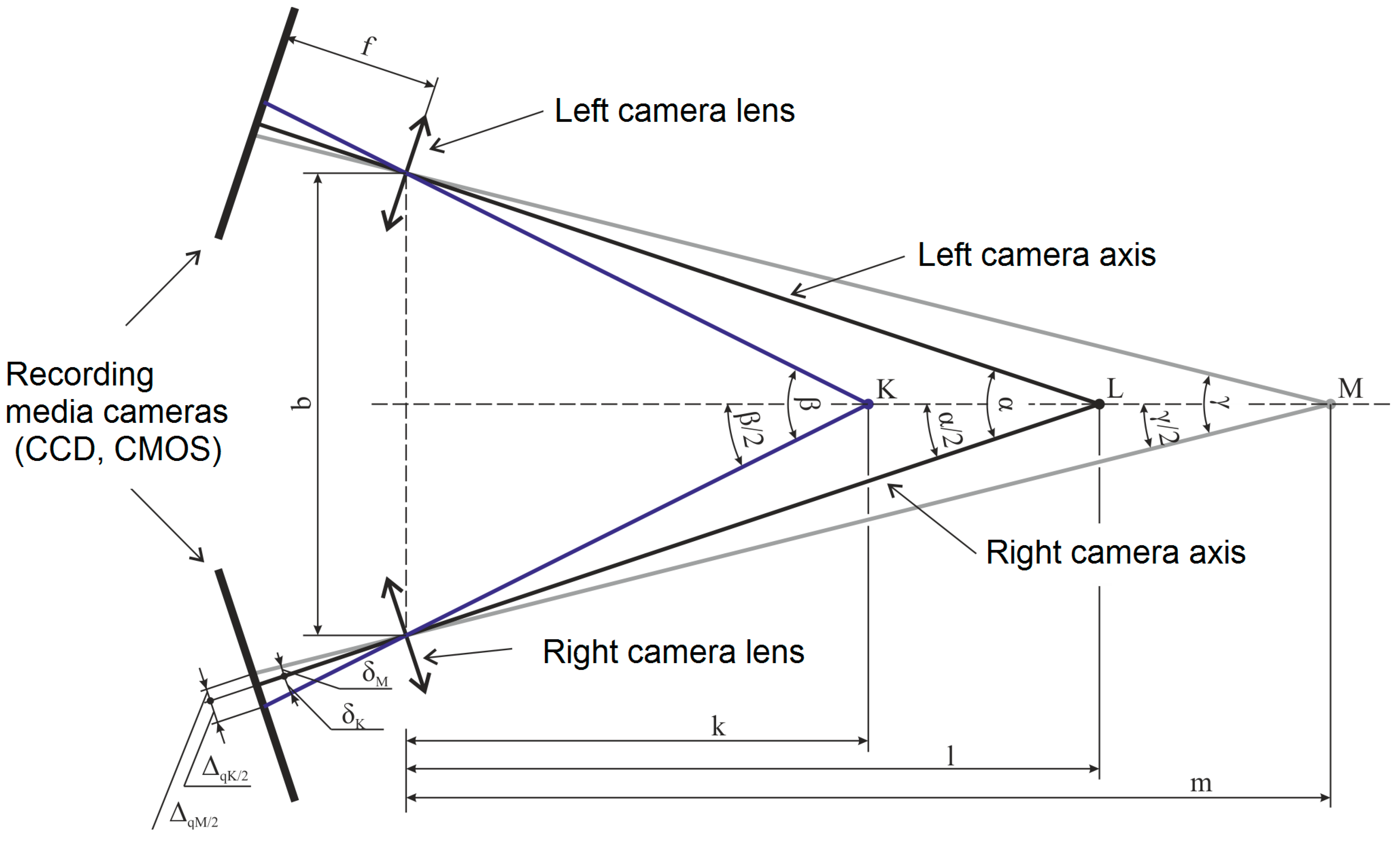

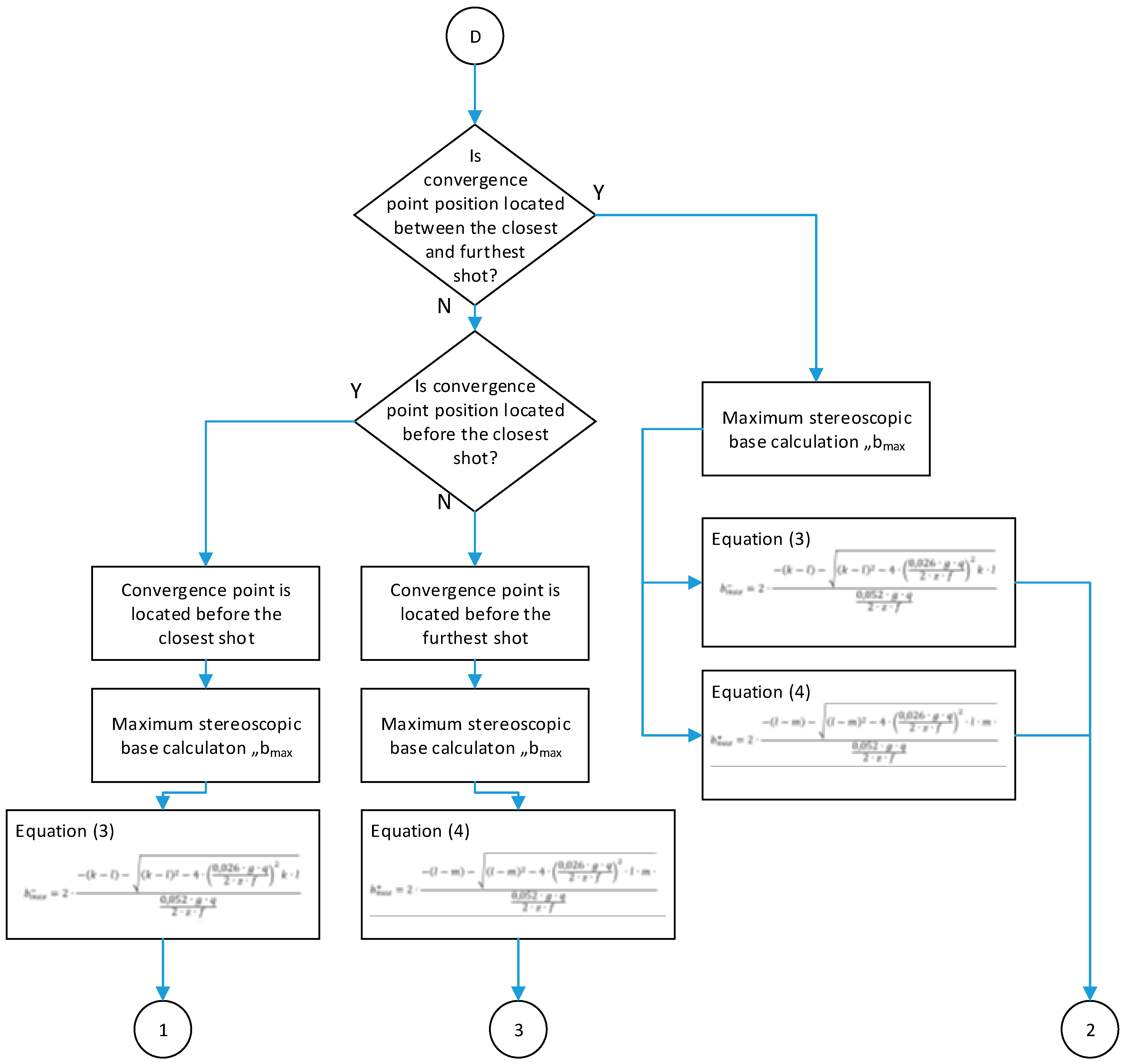
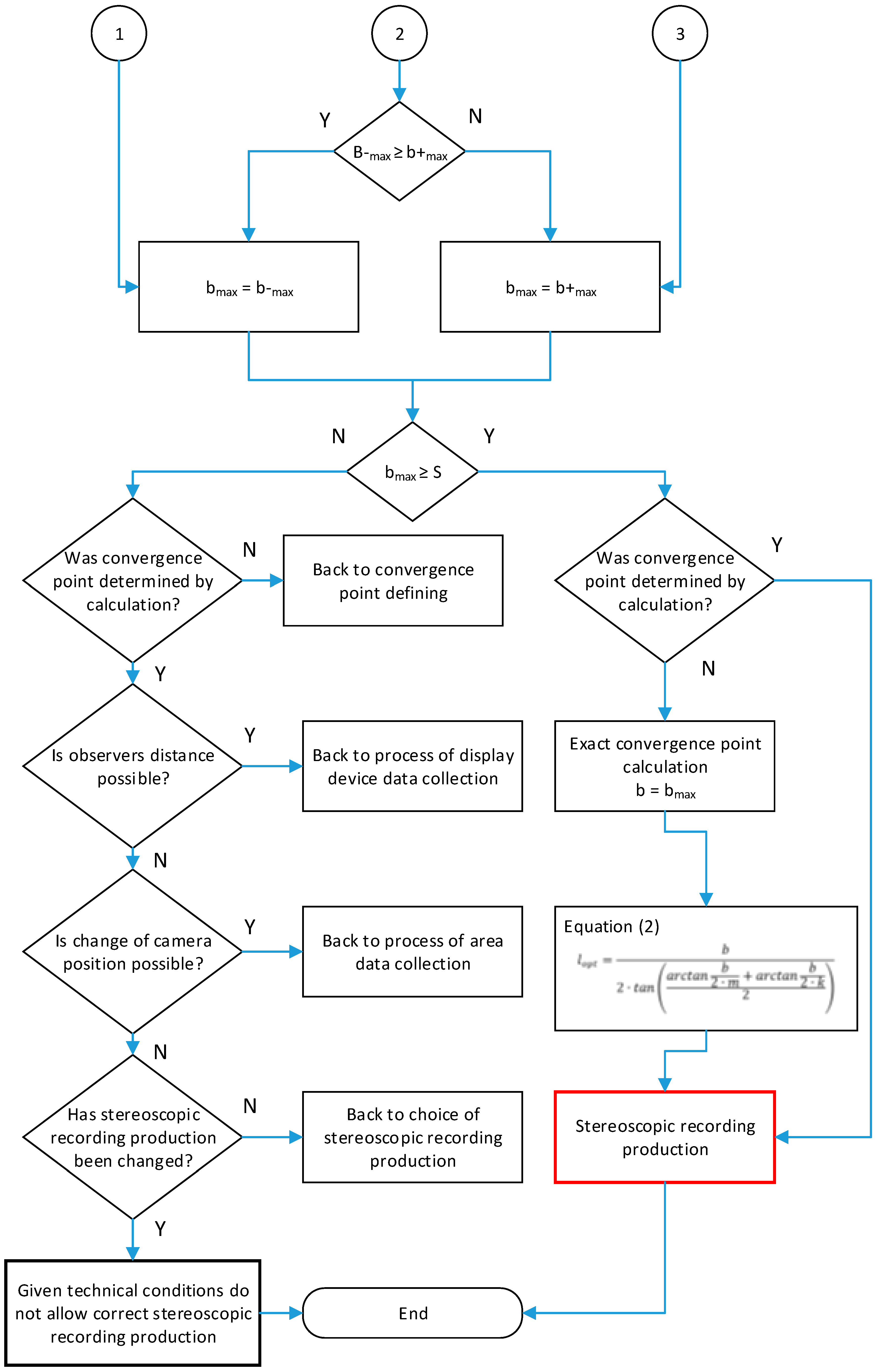

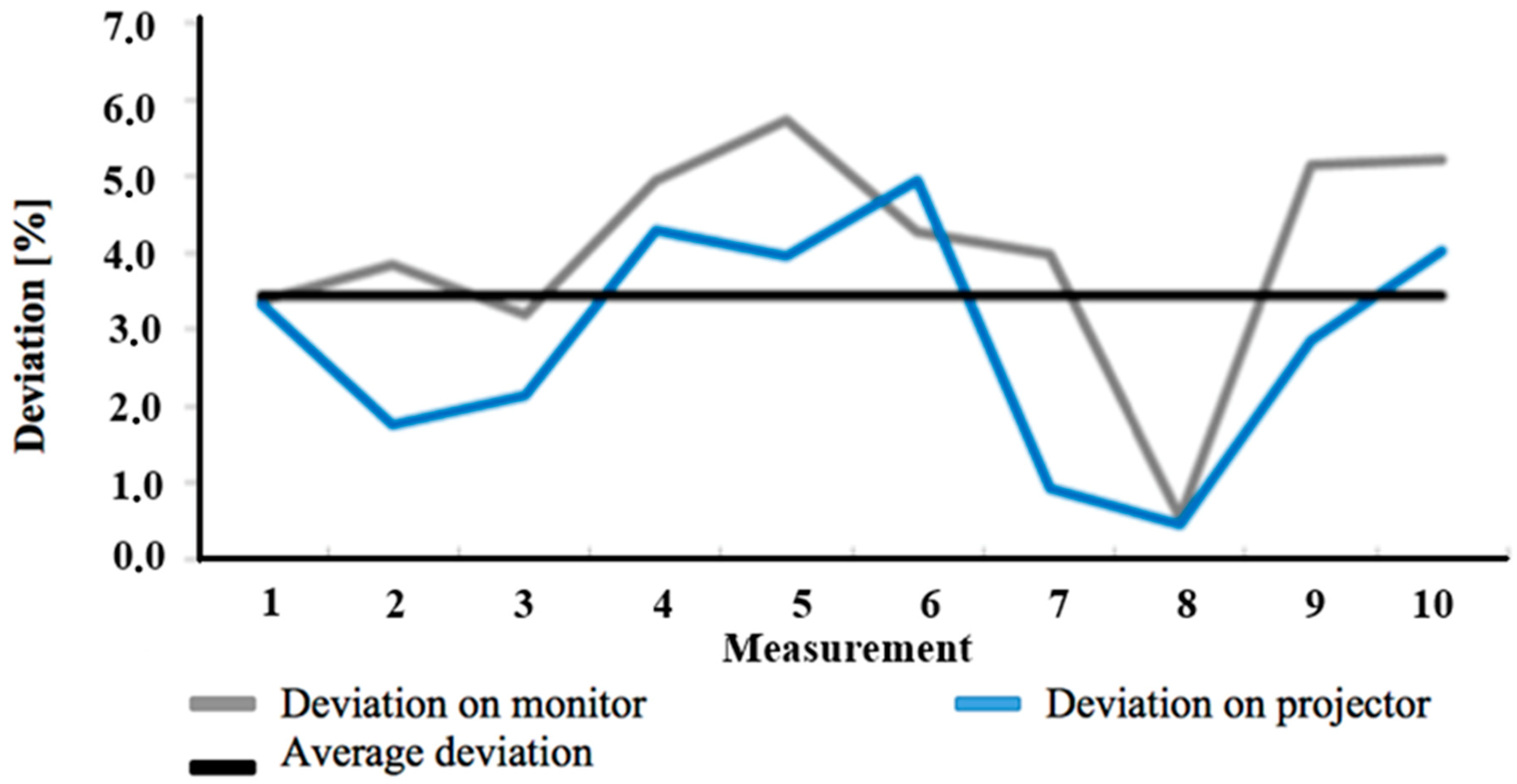
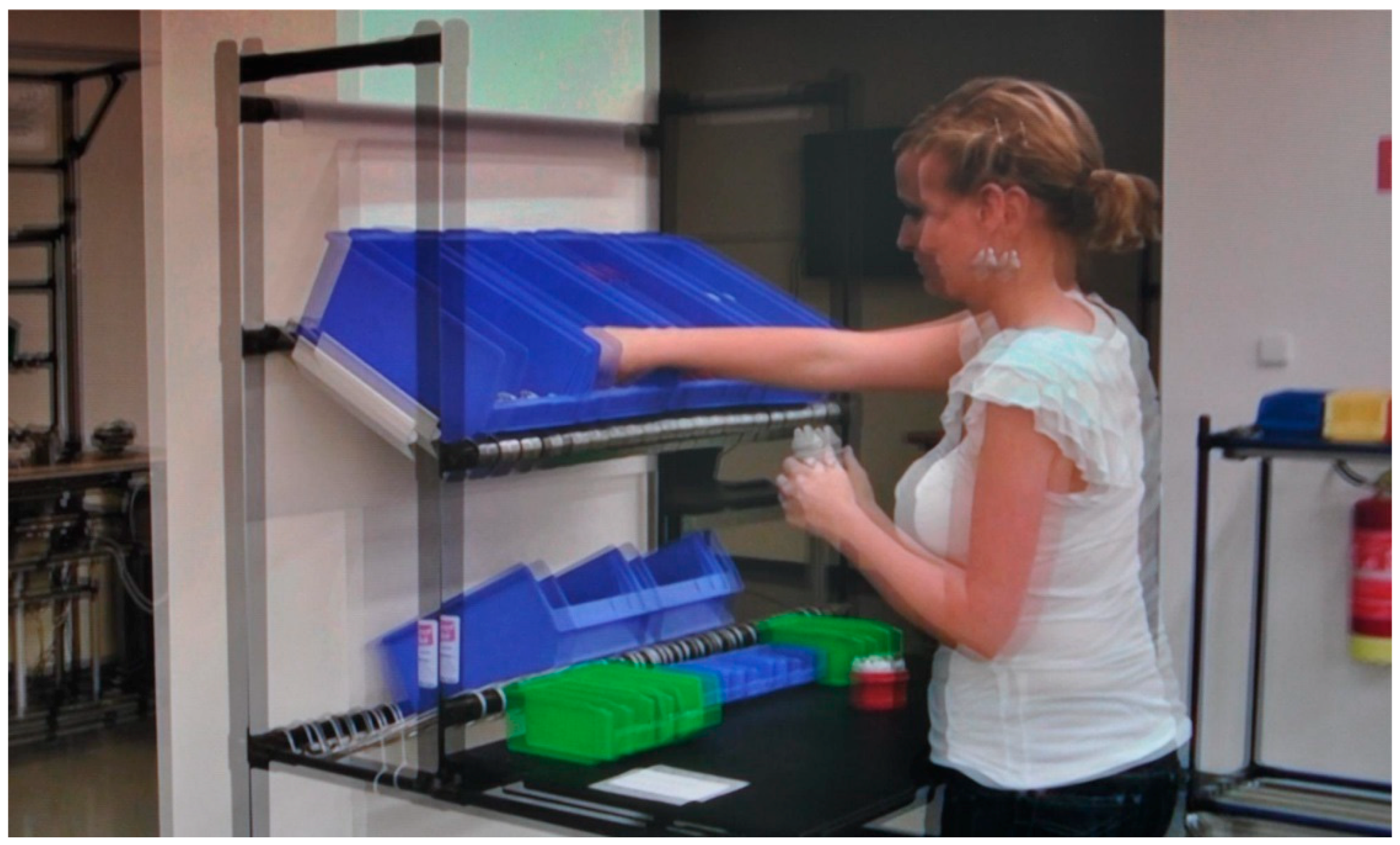

| Number of Position | Input Parameters | Calculated Parameters | Measured Parameters | Deviation [mm] | Deviation [%] | ||||||||
|---|---|---|---|---|---|---|---|---|---|---|---|---|---|
| b [mm] | xK [mm] | xL [mm] | xM [mm] | z [mm] | ΔzK [mm] | ΔzM [mm] | ΔzK [mm] | ΔzM [mm] | ΔzK [mm] | ΔzM [mm] | ΔzK [%] | ΔzM [%] | |
| 1 | 40 | 2500 | x | x | 473 | 9.19 | x | 9.5 | x | 0.31 | x | 3.37 | x |
| 1810 | 35.17 | x | 34 | x | 1.17 | x | 3.33 | x | |||||
| 2 | 63.5 | 2000 | x | x | 473 | 16.85 | x | 17.5 | x | 0.65 | x | 3.86 | x |
| 1810 | 69.78 | x | 71 | x | 1.22 | x | 1.75 | x | |||||
| 3 | 44 | 900 | 1000 | 1250 | 473 | 2.81 | 5.05 | 2.9 | 4.8 | 0.09 | 0.25 | 3.2 | 4.95 |
| 1810 | 10.73 | 19.33 | 10.5 | 18.5 | 0.23 | 0.83 | 2.14 | 4.29 | |||||
| 4 | 44 | 853 | 1000 | 1334 | 473 | 4.35 | 6.33 | 4.6 | 6.6 | 0.25 | 0.27 | 5.75 | 4.27 |
| 1810 | 16.66 | 24.2 | 16 | 23 | 0.66 | 1.2 | 3.96 | 4.96 | |||||
| 5 | 63.5 | 810 | 1000 | 1350 | 473 | 8.54 | 9.45 | 8.2 | 9.5 | 0.34 | 0.05 | 3.98 | 0.53 |
| 1810 | 32.7 | 36.16 | 33 | 36 | 0.3 | 0.16 | 0.92 | 0.44 | |||||
| 6 | 63.5 | 580 | 1000 | 1130 | 473 | 26.36 | 4.22 | 25 | 4 | 1.36 | 0.22 | 5.16 | 5.21 |
| 1810 | 100.89 | 16.15 | 98 | 15.5 | 2.89 | 0.65 | 2.86 | 4.02 | |||||
| Stereoscopic Recording Process Steps | Time Consumption of Steps | |
|---|---|---|
| 2D Recording Production | 3D Recording Production | |
| Selection of suitable camera position | 3 min | 3 min |
| Camera system parameter setting | 0 min | 2 min |
| Recording making | 15 min | 15 min |
| Recording processing and editing | 15 min | 20 min |
| ∑ | 33 min | 40 min |
| ∑ | 100% | 120% |
© 2019 by the authors. Licensee MDPI, Basel, Switzerland. This article is an open access article distributed under the terms and conditions of the Creative Commons Attribution (CC BY) license (http://creativecommons.org/licenses/by/4.0/).
Share and Cite
Gašo, M.; Krajčovič, M.; Dulina, Ľ.; Grznár, P.; Vaculík, J. Methodology of Creating and Sustainable Applying of Stereoscopic Recording in the Industrial Engineering Sector. Sustainability 2019, 11, 2194. https://doi.org/10.3390/su11082194
Gašo M, Krajčovič M, Dulina Ľ, Grznár P, Vaculík J. Methodology of Creating and Sustainable Applying of Stereoscopic Recording in the Industrial Engineering Sector. Sustainability. 2019; 11(8):2194. https://doi.org/10.3390/su11082194
Chicago/Turabian StyleGašo, Martin, Martin Krajčovič, Ľuboslav Dulina, Patrik Grznár, and Juraj Vaculík. 2019. "Methodology of Creating and Sustainable Applying of Stereoscopic Recording in the Industrial Engineering Sector" Sustainability 11, no. 8: 2194. https://doi.org/10.3390/su11082194






